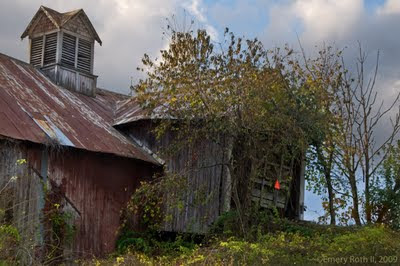 ANSEL ADAMS: "The negative is the equivalent of the composer's score, and the print the performance."
ANSEL ADAMS: "The negative is the equivalent of the composer's score, and the print the performance."PHOTOGRAPHER'S JOURNAL: I'm suddenly aware that I'm spending more time than ever revising images in Photoshop. It's not a bad thing; I still shoot more than I fiddle. In part, I think this is a natural result of drilling more deeply into the program and finding new ways to combine procedures, but I also think it is driven, in part, by my use over the past few months of HDR. If nothing else, HDR has drawn me toward situations of "impossible" lighting, and impossible lighting has led to post-processing fixes. But it has pushed my editing skills in other ways as well.
Without HDR this shot isn't impossible, but it's very dull. There's a branch that angles down and stands in relief just where the roof shadow is darkest. It is a detail I especially like, and below it is a ripple of vines that catches a ray of sunlight. Neither of these were clear to me in the two images I had shot to use for an HDR. In the exposure that let me capture sky, no matter what I did, that branch, at best, looked like obscure texture on the background barn boards. In the brighter exposure the background shadow was so bright that the leaves, though well formed, looked relatively flat and uninteresting. HDR technology combined information on the deep shadow from the overexposed original that revealed the hay wagon properly and preserved information about the color of the bright leaves from the underexposed image that was set to capture the sky. In the HDR software I could play with this balance and see what the whole might be. It was there that I saw, perhaps remembered, the bit of drama in the contrast of leaves and shadowed barn.
Unfortunately, the wind that day was blowing hard, and the leaves in the HDR looked like a double exposure. The actual HDR was useless. I made plans to come back, but on this day I had a useful sky, and when I did get back the hay wagon was gone, the hay stacked deep inside. However, I looked at the HDR with its double-exposed leaves, and I knew how I wanted the tones pulled together. Back in Photoshop I could combine the best of both images manually and then carefully adjust brightness, contrast, and saturation in carefully localized areas until the image was toned and colored as I had seen it in the HDR. The HDR software had let me sketch it.
Efforts such as this have led me to drill yet deeper into Photoshop tools and make many sorts of small adjustments I might not have made a year ago. Now, even when I don't need to make an HDR, I have a greater facility to make changes. As to the kinds of changes I'm making digitally, they are not very unlike what Anselm Adams taught photographers to do chemically in printing. However, digital processing allows infinitely more control and a much shorter learning curve. Of course, it also opens the doors to almost anything.







